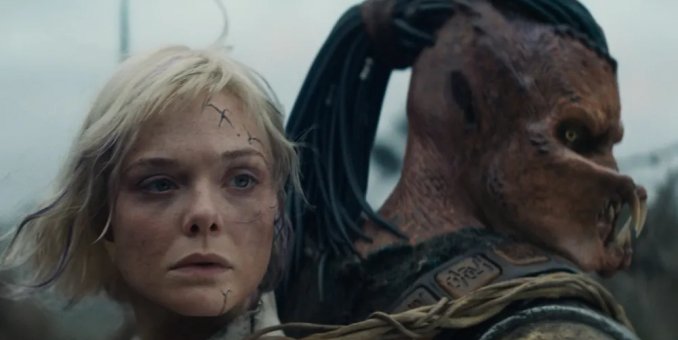
But with Predator: Badlands, director Dan Trachtenberg flips that formula on its head. Humans are not the point of view characters here, a Predator is. (In fact, strictly speaking, there are no actual humans in this movie at all.) And it is this Predator who finds themselves trying to survive against a hostile alien world, using their skills to improvise their way out of numerous, deadly situations.
The movie opens with a Predator, Dek, barely escaping being killed by his own father for being the runt of their clan. Vowing to prove his strength and worth – which is really one and the same for Predators – he heads to the alien world of Genna. There, he plans to hunt down a beast so ferocious that even his father is scared of it, known as a kalisk. But things don’t go quite as planned and Dek soon finds himself on a world where it seems every bit of flora and fauna has evolved to try and kill him.
But Dek isn’t the only intelligent being on the planet. A group of artificial humans, synthetics, from Earth have landed as part of a scientific mission to capture a kalisk for their builders, the Weyland-Yutani Corporation. One of the synths, Thia (Elle Fanning), has been damaged in an encounter with the kalisk and left in the jungles, where she is found by Dek. The two team up ostensibly for survival, but find more reasons to stick together.
After overseeing two previous Predator entries – 2022’s Prey and the animated anthology Killer Of Killers from earlier this year – Trachtenberg completes his rehabilitation of the moribund franchise with Badlands. And it is a rousing and engaging science-fiction action film that has come along for some time while also serving up both strong characterization and world building.
The relationship setup between Tessa and Dek may draw inspiration from 1985’s Enemy Mine, but it satisfactorily grows in its own way. A good combination of screenplay and Dimitrius Schuster-Koloamatangi’s acting helps to make Dek not just the most fleshed out Predator we’ve met, but one of the most interesting characters in the franchise overall, no matter their species. And it is fun to see Dek learn the lesson that many humans who have faced off against his Predator brethren learned – Predator technology may be no match for sheer ingenuity and the ability to use things in the natural world as weapons.
If the name “Weyland-Yutani” sounds familiar, it is because they are the big corporation lurking in the background of the Alien franchise. I personally have never been much of a fan of the idea of crossing over the Predator and Alien films. At most, setting a Predator against a xenomorph seems like an exercise in two smashing two nearly unstoppable forces into one another. The true story would center on the humans caught in the middle of such a conflict. Unfortunately, the previous two cinematic attempts at this did not come together in a satisfactory way.
Trachtenberg, however, has found a rather simple and much more satisfying way to cross-pollinate the two franchises. Simply leave out the xenomorph and concentrate on what some (OK, me at least) would say are the true villains of the Alien series – The Weyland-Yutani Corporation. They have known of the xenomorphs’ existence and constantly put employees into situations where they will most likely die so that they can try and capture one of the killer aliens in order to find ways to exploit it as a weapon. Much like this fall’s Alien: Earth TV series on FX, Badlands sees Weyland-Yutani scouring the galaxy for any type of alien life form it can somehow make a profit off of. Of course, the film will probably leave one with a few new questions about Predators, the Weyland-Yutani Corporation, and how the next interaction between the two will go.
Is Predator: Badlands a perfect film? No, but it is perfectly entertaining. Trachtenberg has constructed a high-energy science-fiction action adventure that offers more than just some token characterizations for its heroes.





